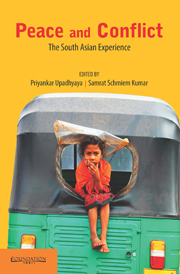Book contents
- Frontmatter
- Contents
- Foreword
- Preface
- Introduction
- 1 Conflict Resolution and Peacebuilding: Ideas, Approaches and Debates
- 2 Changing Perspectives on Peace Studies in South Asia
- 3 Peace Pedagogies in South Asia: Interreligious Understanding
- 4 Responses of Communities to Social Tension
- 5 Plurality of Peace, Non-violence and Peace Works in India
- 6 Education and Culture of Peace: Engaging with Gandhi
- 7 Structural Violence and Human Security: Gandhi's Visions
- 8 Women and the Peace Process in Nepal
- 9 Quest for Peace and Justice in Pakistan: Lawyers' Non-violent Resistance
- 10 Antinomies of Democracy and Peace in Nepal
- 11 Post-armed Conflict Trajectories in Sri Lanka
- 12 Environmental Security and Conflict in Bangladesh: Nature, Complexities and Policies
- Contributors
- Bibliography
- Index
4 - Responses of Communities to Social Tension
Published online by Cambridge University Press: 05 October 2014
- Frontmatter
- Contents
- Foreword
- Preface
- Introduction
- 1 Conflict Resolution and Peacebuilding: Ideas, Approaches and Debates
- 2 Changing Perspectives on Peace Studies in South Asia
- 3 Peace Pedagogies in South Asia: Interreligious Understanding
- 4 Responses of Communities to Social Tension
- 5 Plurality of Peace, Non-violence and Peace Works in India
- 6 Education and Culture of Peace: Engaging with Gandhi
- 7 Structural Violence and Human Security: Gandhi's Visions
- 8 Women and the Peace Process in Nepal
- 9 Quest for Peace and Justice in Pakistan: Lawyers' Non-violent Resistance
- 10 Antinomies of Democracy and Peace in Nepal
- 11 Post-armed Conflict Trajectories in Sri Lanka
- 12 Environmental Security and Conflict in Bangladesh: Nature, Complexities and Policies
- Contributors
- Bibliography
- Index
Summary
I
Introduction
This chapter is concerned with the ways in which different communities react to social tensions. These tensions arise because of one or a multiplicity of reasons, thus yielding conflict, manifest and/or latent. Tension may prevail after an instance of open conflict – an episode of violence and enmity – has subsided for the time being, but it can always surface with greater intensity, causing immeasurable loss to material as well as nonmaterial aspects of culture.
The point I wish to put forth is that sometimes administrative and political institutions do not respond to social tensions. On the contrary, they look through them, neither denying their existence nor accepting their prevalence. Against such a backdrop, the communities are left with no other alternative except to devise their own solutions to social tensions, whether they are between different sections of the same community or between different communities. Perhaps the administrative and political institutions tacitly believe that the tensions would subside on their own – on the contrary, they think, any external intervention would further exacerbate the tensions; thus, the administrative and political institutions adopt an instance of what is famously called the ‘conspiracy of silence’, or to put this idea in other words, ‘give nature a chance to heal’, or ‘do nothing, nothing will be done, and the problems will be solved (or pushed to a state of insignificance) on their own’.
- Type
- Chapter
- Information
- Peace and ConflictThe South Asian Experience, pp. 63 - 81Publisher: Foundation BooksPrint publication year: 2014

